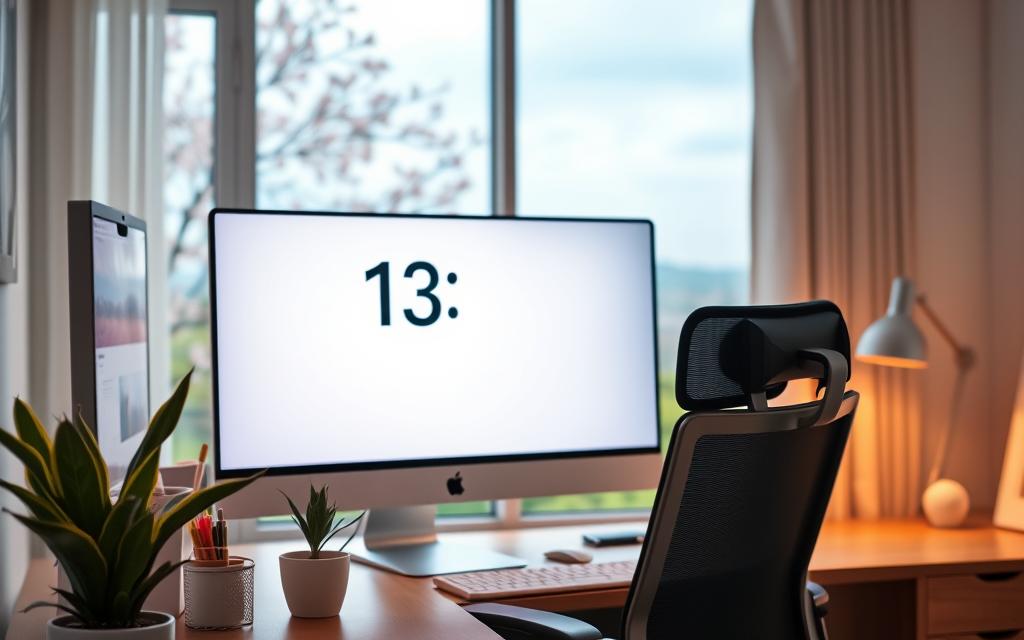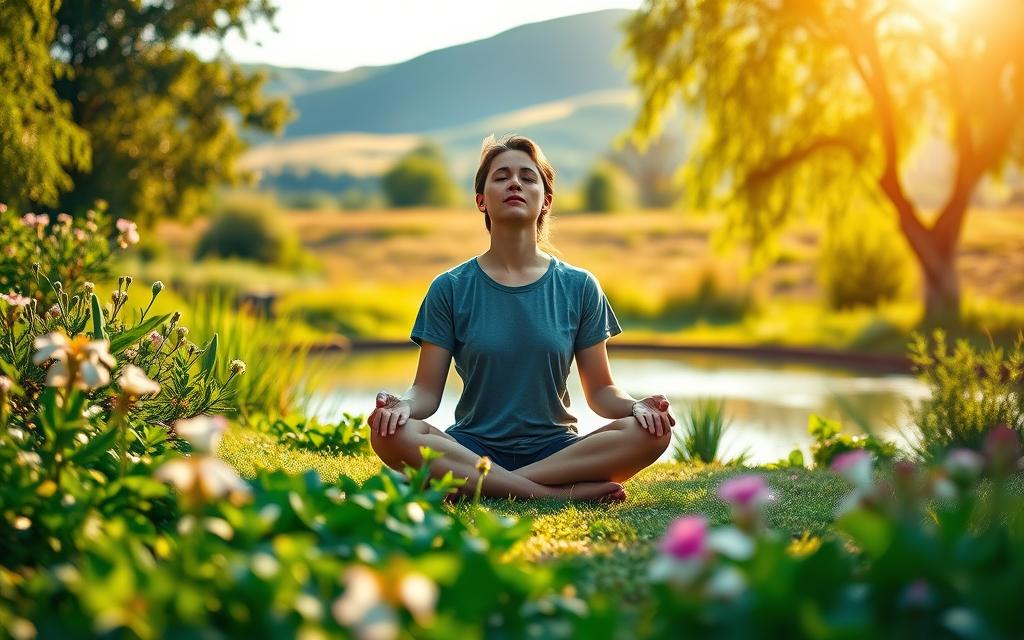Spring is here, and with it, a chance to take a break from screens. Too much time on social media can harm our mental health, making it crucial to rethink our online habits. Instead, let’s enjoy the outdoors and connect with people face-to-face.
Studies show that 60% of people spend less time online as they explore nature. Taking a digital detox can greatly improve our mental health, with 70% seeing the benefits. This article will guide you on how to cut down on social media and boost your well-being as spring arrives.
Key Takeaways
- Spring offers an opportunity to refresh your social media habits.
- Only 15 minutes spent on social media, once or twice a day, is recommended.
- Engaging in outdoor activities can significantly reduce time spent on social networking.
- Taking breaks from social media can enhance mental well-being.
- Many people have considered reducing their social media presence for mental health reasons.
Understanding the Impact of Social Media on Mental Health
Social media can really affect our mental health. A study found that using social media can lead to depression, mainly in kids and teens. With billions of people using social media, this is something we should think about.
Platforms like Facebook, Instagram, and TikTok show us perfect lives. This can make us feel bad about ourselves. Cyberbullying can also hurt our mental health, making us feel more anxious and depressed.
People with serious mental health issues use social media just as much as others. About 70% of them use it to connect. But, this can also mess with our sleep, making our mental health worse.
How we interact on social media matters a lot. Good interactions can help us feel supported. But too much can make us feel lonely and unhappy. Knowing this can help us use social media in a healthier way.
| Impact of Social Media Use | Associated Mental Health Outcomes |
|---|---|
| Increased time spent on social media | Higher levels of anxiety and depression |
| Exposure to curated content | Body image concerns and lower self-esteem |
| Cyberbullying incidents | Increased risk of depression and anxiety |
| Sleep disruption from media use | Poor mental health outcomes |
| Social support through digital channels | Variable impact depending on quality of interaction |
Identifying Your Social Media Triggers
It’s key to know what triggers negative feelings from social media. Think about how you feel after using it. Do you feel good or bad? Knowing this helps us all be more aware of our mental health.
Think about why you use social media. What do you want to get out of it? Figuring this out helps you use it better.
Social media can make us feel many things. It can even make us feel addicted. The likes and comments we get can make us want to post more. This shows how important it is to know what triggers us.
| Trigger | Common Emotional Reaction | Advice |
|---|---|---|
| Receiving fewer likes than expected | Feelings of inadequacy | Limit comparison with others |
| Seeing idealized lifestyles | Envy or jealousy | Curate your feed to include positivity |
| Engaging in trending discussions | Connection or anxiety to fit in | Participate mindfully |
| Negative comments on posts | Discouragement or anger | Consider disabling comments or unfollowing negative accounts |
Understanding social media triggers can help us feel better. Knowing how it affects our mood helps us make better choices online.

Spring Cleaning: Refreshing Your Social Media Feed
Spring is the perfect time for a social media cleanup. It’s a chance to look at your online presence. People spend about 2 hours and 31 minutes daily on social media. Yet, 60% feel overwhelmed by all the content.
Think about the accounts you follow and how they affect your mental wellness. It’s important to choose wisely. Accounts that make you feel good are best.
Unfollowing accounts that make you feel bad can make your feed better. Research shows 80% of users like seeing positive content. This includes good reviews and success stories from brands they like.
If you can’t unfollow, try muting. It’s a softer way to avoid negative content. Following joyful accounts makes social media better. It shows how important it is to have content that matches your values.

Setting Screen Time Limits
Setting screen time limits can greatly help manage social media use, which is more common in the spring. Smartphones have built-in settings to track app use and set time limits. These tools help users control their social media use, leading to better habits.
Creating a schedule for social media use can boost productivity and mindfulness. Studies show that college students with a 30-minute daily limit on social media felt less depressed. This shows that limiting screen time can improve mental health.
Families should talk about their technology use to set screen time limits. A Family Media Plan helps everyone agree on a schedule. For example, extra screen time can be a reward for good behavior, making it easier to stick to the limits.
To show how setting screen time limits works, here’s a table with some strategies and their benefits:
| Strategy | Benefits | Considerations |
|---|---|---|
| Daily Limit for Apps | Reduces symptoms of depression | May be challenging to enforce consistently |
| Engaging in Family Discussions | Promotes understanding and cooperation | Requires open communication and trust |
| Structured Evening Routine | Improves sleep and academic performance | Initial pushback might occur (extinction burst) |
| Offering Extra Screen Time as Reward | Encourages positive behavior | Needs to be implemented fairly |
It’s key for families to stick to their screen time limits. Experts say it’s important not to make exceptions in the first weeks. This helps build healthy screen habits and encourages independence in social media use.

The Importance of Mindful Social Media Engagement
Mindful engagement on social media means being aware of our actions and why we’re doing them. This approach can greatly enhance our online presence. It’s about choosing to interact with content that uplifts us, not just mindlessly scrolling through negative feeds.
Too much social media can raise our stress levels, leading to anxiety and depression. The term “doomscrolling” became popular in 2020, showing how many get caught in endless negative news loops. People might spend two to three hours daily on social media when they’re stressed.
Limiting social media time to 30 minutes during tough times can help. Studies show a 20-30% drop in anxiety and depression when users set these limits. Many use social media to find support, feeling empowered to act on social issues after seeing relevant content. About 75% of users believe social media helps them connect and cope with personal or global challenges.
Mindful engagement also boosts emotional well-being. Those who practice mindfulness see a 40% improvement in mental health after digital detoxes. Setting boundaries around social media use is key for mental clarity. By engaging with supportive groups and unfollowing triggers, we can create a healthier online space. This leads to a more positive and uplifting social media experience.

Creating Healthy Boundaries with Social Networks
It’s important to set limits with social media to keep a healthy balance in life. Make your home tech-free zones, like bedrooms or dining areas. This helps you focus on real-life connections and reduces stress from too much screen time.

Being mindful of how you use social media is key. Studies show that setting rules for social media use can improve your mental health. Limiting your time on these platforms can make you happier and more relaxed.
Finding a balance between online and offline life is crucial. Set daily limits for social media and avoid it before bed to sleep better. Try activities like walking, reading, or meditation to deal with loneliness or anxiety.
| Activity | Suggested Duration | Impact on Well-being |
|---|---|---|
| Social Media Use | Max 2 hours daily | Can lead to anxiety if unchecked |
| Offline Activities | At least 4 hours | Promotes mental health |
| Tech-Free Zones | All day | Enhances personal relationships |
| Digital Detox | 1 day/week | Boosts overall mental health |
Understanding how social media affects you helps set better boundaries. Regular breaks and real-world interactions lead to a more satisfying life.
Finding Meaningful Alternatives to Social Media
Doing things that bring joy outside of screens is key for our happiness. Hobbies like painting, gardening, or exercise are great. They offer real benefits and help us connect with others in the real world.
People who step away from social media often notice better communication with loved ones. Hobbies create shared moments that make our relationships stronger. They also help us meet new people who like the same things.
Switching to offline activities can also lower anxiety from too much online time. Joining local clubs or helping out in the community fills our time with meaning. It makes us feel part of something bigger. Studies show that being with people face-to-face makes us happier and less lonely.
| Activity Type | Benefits | Impact on Real-world Connections |
|---|---|---|
| Art and Crafts | Stimulates creativity and mental wellness | Encourages sharing and community engagement |
| Physical Activities | Improves physical health and reduces stress | Fosters teamwork and camaraderie |
| Volunteer Work | Provides a sense of purpose and fulfillment | Builds connections within the community |
| Outdoor Adventures | Enhances mood and mental clarity | Builds lasting friendships through shared experiences |

Practicing Digital Detox During Spring
Spring brings a strong urge to scroll through social media. Taking a digital detox can be a great way to live healthier. It means stepping away from screens to improve your mind and body.
Outdoor activities like hiking or biking are great replacements. They offer real-life experiences instead of endless scrolling.

Many feel overwhelmed by social media, with 70% of users feeling this way. A digital detox can help, with 54% wanting to take a break. People find time for card games, yoga, and cooking, boosting creativity and family ties.
Starting a detox can be tough, but it’s worth it. Studies show a 25% boost in well-being from outdoor activities. Being in nature reduces the need to check phones.
Creating screen-free weekends can help keep this balance. It’s called #scrollfreeweekend.
| Activity | Improvement in Well-Being (%) | Time Freed Up (Hours/Day) |
|---|---|---|
| Yoga | 25% | 1 |
| Cooking | 30% | 1.5 |
| Hiking | 20% | 2 |
| Card Games | 15% | 0.5 |
Mindful practices can cut down on social media use. Recognizing its negative effects on work life helps set better tech boundaries. As spring arrives, spending time outdoors can make digital detox more rewarding.
Prioritizing Real-Life Connections Over Online Presence
Making real-life connections is key to emotional health. Social media helps us stay in touch, but nothing beats face-to-face talks. Focusing on in-person relationships makes life richer and builds stronger community bonds.
Studies show that talking to people face-to-face cuts down loneliness and boosts happiness. People who choose real-life talks over online ones see a 20% jump in relationship happiness. Meaningful talks can even lift mental health by 30% more than just scrolling through feeds.
Too much social media can make us feel like we’re not really connecting. It’s easy to get lost in endless notifications. By setting limits, like meeting people in person and making phone-free areas, we can improve our relationships. About 70% of people who cut down on social media feel less anxious and more focused.
Limit Unnecessary Notifications
Notifications can be a big distraction, making it hard to focus and leading to less productive social media use. It’s important to manage notifications well by turning off alerts from apps you don’t need. This helps cut down on social media alerts that can cause stress and unnecessary engagement.
Too much internet use can hurt productivity. Workers who check social networks a lot during work hours have trouble focusing. This can make them less effective at their jobs. Companies might set rules for internet use to help everyone stay focused.
It’s a good idea to only check social media at set times, like during breaks. This helps avoid acting on impulse because of constant alerts. Also, keeping phones away can help you stay focused on what you need to do.
Tools for managing social media can make it easier to keep up with different accounts without getting overwhelmed by alerts. Apps like Offtime and Freedom are becoming more popular, showing the need for good ways to handle notifications.
The line between online and offline life can get fuzzy, affecting our mental health. Setting boundaries, like having “screen-free” hours, can make us happier and more connected to the world around us.
Using Social Media Strategically for Self-Promotion
Using social media well means having a plan for self-promotion. Small businesses and brands can really benefit from posts that match their goals. Content that grabs attention helps build strong connections with people.
Studies show that growing companies are better at social media. They get more positive feedback than companies that don’t grow. In today’s competitive world, marketing your brand well is key.
Social media plays five main roles in professional services: networking, promoting content, SEO, research, and finding new talent. Half of these firms now prefer social media for networking over email. A smart strategy helps brands overcome social media’s challenges.
To do well on social media, you need clear goals. These goals are about doing, reaching, and getting results. By setting targets, you can see if your marketing is working.
Social media is great because it lets you reach many people at once. Creating content that people care about is crucial. Executives use social media to boost their personal brand, showing self-promotion is more than just old ways.
Video content is a big hit, getting shared way more than text or images. This shows its power for self-promotion. Keeping your brand consistent can increase recognition by 80%. Talking to followers can make them 20% more loyal, showing the value of interaction.
Recognizing When to Take a Break from Social Media
People spend an average of 2 hours and 27 minutes daily on social media. Knowing when to take a social media break is key for digital wellness. Seeing perfect images and updates can make us feel not good enough. In fact, 62% of Facebook and Twitter users feel their achievements are less than others’ posts.
This comparison can hurt our mental health awareness. It can make us feel lonely and lower our self-esteem.
Spotting burnout signs is vital. Many scroll through feeds before bed, which can mess up sleep. Thirty percent of users say they feel more isolated because of social media. Despite its aim to connect, it can make us feel overwhelmed and unhappy.
A break can help us clear our minds and find balance again.
Social media is made to keep us hooked, with features like endless scrolling. Taking a break can improve our mental health. Studies show it can reduce depression and loneliness.
By paying attention to our feelings, we can set healthy limits. This leads to better habits and a happier life.
How Digital Marketing Can Ease Your Social Media Burden
Managing social media can be overwhelming for many companies. It often slows down their work. About 70% of marketers struggle to handle their digital marketing and other tasks. A good content strategy can help a lot.
Automation tools are key in easing social media management. For example, Socedo can help businesses grow their followers by up to 30%. These tools make routine tasks easier, letting marketers focus on important work.
Using the right tools can make social media work more efficient. SecureMySocial helps reduce risks from social media policy mistakes. Oktopost improves ROI tracking by up to 50%, which is great for B2B companies.
| Digital Marketing Tool | Benefit | Statistical Improvement |
|---|---|---|
| Socedo | Follower Growth | Up to 30% |
| SecureMySocial | Policy Violation Mitigation | 30% of employees impacted |
| Oktopost | ROI Measurement Accuracy | Up to 50% |
| BuzzSumo | Website Traffic Increase | 200% |
Training programs, like those from the British Academy for Training and Development, show the value of learning. People spend 25% less time on social media after training. Workshops also help teams work better together, boosting social media success by up to 40%.
With almost 5 billion social media users worldwide, a solid digital marketing plan is crucial. Using features like ‘Buy Now’ buttons can increase engagement. Also, using popular content types like Instagram Reels and live videos can really boost interaction.
Conclusion
As spring arrives, it’s key to balance our social media use for our mental health. Social networks are great for staying connected and sharing info. But, too much screen time can be bad. Taking a digital detox helps us step back and focus on real-life connections.
By setting limits, managing alerts, and making real friends, we can cut down on social media. This way, we avoid misunderstandings that come from text alone. Learning to communicate better online makes our interactions more meaningful.
Adopting a balanced approach to social media can make our lives more fulfilling. Mixing fun social times with personal reflection helps us find a healthy balance. This way, we build strong connections and enjoy the good parts of social networking.
FAQ
How can I reduce my social media usage during spring?
To cut down on social media, set screen time limits. Unfollow accounts that make you feel bad. Try outdoor activities to connect with real people.
What are some of the negative effects of excessive social media engagement?
Too much social media can make you feel anxious, depressed, and not good enough. This is because of constant comparisons on sites like Instagram and TikTok.
How can I identify my social media triggers?
Think about how you feel after using social media. Ask yourself why you use it. Understanding these feelings can help you change your social media habits.
Why is it important to refresh my social media feed in spring?
Refreshing your feed lets you choose content that makes you happy. This improves your online experience.
What strategies can I use to set screen time limits?
Most phones have tools to track and limit social media use. These features help you use your phone more wisely.
How can I practice mindful social media engagement?
Pick the content you want to see. Interact with posts that inspire you. Avoid scrolling without a purpose to improve your mental health.
What are healthy boundaries to establish with social media?
Make tech-free areas like your bedroom or dining room. This encourages more face-to-face time and reduces social media’s impact.
What alternatives to social media can I explore during spring?
Try hobbies like painting, gardening, or exercise. These activities can bring joy and help you connect with others in real life.
How can I perform a digital detox?
A digital detox means taking a break from social media. Use this time for outdoor activities to refresh your mind and body.
Why are real-life connections essential over online presence?
Face-to-face interactions improve your emotional health. They offer support and fulfillment that online interactions can’t match.
How can I limit unnecessary notifications from social media?
Turn off alerts for apps you don’t need. This reduces distractions and helps you focus on what you’re doing.
How can I use social media strategically for self-promotion?
Create posts that match your goals. Use analytics to make your content more engaging. This way, you can be online without feeling overwhelmed.
What signs indicate I should take a break from social media?
If social media makes you feel burned out or negative, it’s time to take a step back. Reassess how you use it.
How can digital marketing ease my social media management?
Good content strategies can help you stay online without spending too much time on it. This makes your social media use healthier.
Source Links
- https://shanabull.com/blog/social-distance-yourself-from-social-media-how-to-spring-clean-your-social-media-habits – Social Distance Yourself From Social Media: How To Spring Clean Your Social Media Habits — Shana Bull, Digital Marketing
- https://meetedgar.com/blog/cleaning-your-social-media-strategy – 5 Steps for Spring Cleaning your Social Media
- https://www.littledogsocialmedia.com/spring-into-action-social-media-strategies-for-a-blooming-season/ – Spring Into Action: Social Media Strategies for a Blooming Season – Little Dog Social Media
- https://pmc.ncbi.nlm.nih.gov/articles/PMC10476631/ – The Impact of Social Media on the Mental Health of Adolescents and Young Adults: A Systematic Review
- https://pmc.ncbi.nlm.nih.gov/articles/PMC7785056/ – Social Media and Mental Health: Benefits, Risks, and Opportunities for Research and Practice
- https://bmcpsychology.biomedcentral.com/articles/10.1186/s40359-023-01243-x – Pros & cons: impacts of social media on mental health – BMC Psychology
- https://www.goaro.com/blog/6-psychological-triggers-behind-social-media-addiction?srsltid=AfmBOormJAtskVDYK2Ym95viQ4AnSwuWqHUGIB0ZwYY3PwZtujeGBQHP – 6 Psychological Triggers Behind Social Media Addiction
- https://highland-marketing.com/resources/boost-engagement-social-media-triggers/ – Boost engagement with proven social media triggers
- https://www.linkedin.com/advice/3/how-can-you-identify-potential-crisis-triggers-yumfe – How can you identify potential crisis triggers on social media?
- https://www.sesamecommunications.com/blog/8-tips-to-clean-up-your-social-media-pages-this-spring/ – 8 Tips to Clean Up Your Social Media Pages This Spring – Dental Marketing & Practice Management | Sesame Communications
- https://bluetext.com/blog/15-ways-to-spring-clean-and-refresh-your-social-media-presence/ – 15 Ways to Spring Clean and Refresh Your Social Media Presence | Bluetext
- https://www.pipelinesocialmedia.com/blog/5-tips-for-spring-cleaning-your-social-media/ – BLOG | 5 Tips For Spring Cleaning Your Social Media
- https://www.aap.org/en/patient-care/media-and-children/center-of-excellence-on-social-media-and-youth-mental-health/qa-portal/qa-portal-library/qa-portal-library-questions/impact-of-limiting-time-spent-on-social-media/?srsltid=AfmBOorABwAcvcFeCIK2AcXjLb9g4ftUYyx-Qfa_pYJ4V6ydkoZteE2q – Impact of Limiting Time Spent on Social Media
- https://childmind.org/article/how-to-set-limits-on-screen-time/ – How to Set Limits on Screen Time – Child Mind Institute
- https://www.chconline.org/resourcelibrary/how-to-help-young-people-limit-screen-time-and-feel-better-about-how-they-look/ – How to Help Young People Limit Screen Time — and Feel Better About How They Look
- https://www.activeminds.org/blog/mindful-consumption-of-social-media-can-support-our-mental-health/ – Mindful Consumption of Social Media Can Support Our Mental Health
- https://care-clinics.com/mindful-social-media-use/ – Mindful Social Media Use
- https://pmc.ncbi.nlm.nih.gov/articles/PMC9760919/ – The effect of mindfulness on online self-presentation, pressure, and addiction on social media
- https://www.uab.edu/news/youcanuse/item/12851-how-to-set-healthy-boundaries-on-social-media – How to set healthy boundaries on social media
- https://mindfulhealthsolutions.com/how-to-set-social-media-boundaries-to-protect-your-mental-health/ – How To Set Social Media Boundaries To Protect Your Mental Health
- https://nddtreatment.com/setting-healthy-boundaries-with-social-media/ – Setting Healthy Boundaries With Social Media
- https://jedfoundation.org/resource/understanding-social-media-use-and-balance/ – Understanding Social Media Use and Balance | JED
- https://www.helpguide.org/mental-health/wellbeing/social-media-and-mental-health – Social Media and Mental Health: Social Media Addiction
- https://www.apu.apus.edu/area-of-study/business-and-management/resources/how-social-media-sites-affect-society/ – Social Media Impact: How Social Media Sites Affect Society
- https://commit30.com/blogs/commit30/unplugged?srsltid=AfmBOoqU3_yr8tK2ZGXeseMwUtRpf_M8oseeWFngkc7yLiuI-69X2GjV – About my Annual Digital Detox this Spring
- https://purelyelizabeth.com/blogs/purely-elizabeth/social-media-managers-spring-digital-detox-guide?srsltid=AfmBOorSwr1KnmGDSUzlE0e7PdCX53gBPUtxRLwQ6J0VN2VFFv-LY3WF – Our Social Media Manager’s Guide to Digital Detoxing
- https://blog.trevecca.edu/thehill/prioritizing-meaningful-connections-in-a-digital-age – Prioritizing Meaningful Connections in a Digital Age
- https://geediting.com/people-who-successfully-balance-social-media-and-real-life-often-follow-these-9-rules/ – People who successfully balance social media and real life often follow these 9 rules
- https://debrasmouse.com/balancing-life-and-social-media-how-to-maintain-wellness-in-a-digital-age/ – Balancing Life and Social Media: How to Maintain Wellness in a Digital Age
- https://www.lumiun.com/blog/en/11-tips-to-reduce-wasted-time-on-social-media-during-work/ – 11 tips to reduce wasted time on social media while working
- https://thegracetogrow.com/limiting-social-media-in-your-life-keeping-the-balance-of-power-in-check/ – How to Limit Social Media Use in Your Life
- https://hingemarketing.com/blog/story/using-social-media-for-marketing-professional-services – Using Social Media for Marketing Professional Services – Hinge Marketing
- https://www.brandofaleader.com/blog/how-to-market-your-personal-brand-on-social-media – How to Market your Personal Brand on Social Media
- https://summer.harvard.edu/blog/need-a-break-from-social-media-heres-why-you-should-and-how-to-do-it/ – Need a Break from Social Media? Here’s Why You Should — and How to Do It – Harvard Summer School
- https://health.clevelandclinic.org/signs-you-need-to-take-a-break-from-social-media – 9 Signs To Take a Social Media Break
- https://batdacademy.com/en/post/tools-that-ease-the-burden-of-social-media-marketing – Tools That Ease the Burden of Social Media Marketing
- https://www.fcnews.net/2023/02/upping-the-ante-on-your-social-media-marketing/ – Upping the ante on your social media strategy in 2023 – Floor Covering News
- https://www.huffpost.com/entry/why-you-shouldnt-jump-to-conclusions-on-social-media_b_5a4273afe4b06cd2bd03dcb7 – Why You Shouldn’t Jump To Conclusions on Social Media
- https://www.emarketinginstitute.org/free-ebooks/social-media-marketing-for-beginners/chapter-25-conclusion-importance-social-media-marketing/ – Chapter 25: Conclusion: The Importance of Social Media in Marketing – eMarketing Institute
- https://americancoinop.com/node/123940 – Social Media Strategizing (Conclusion)
